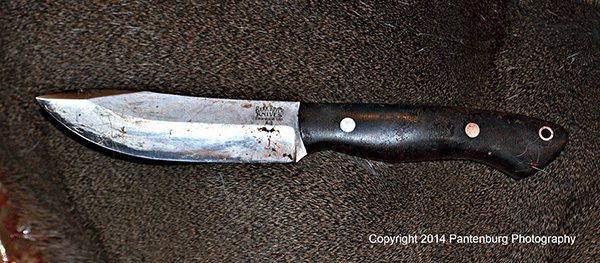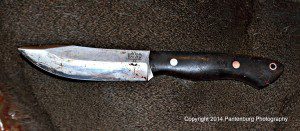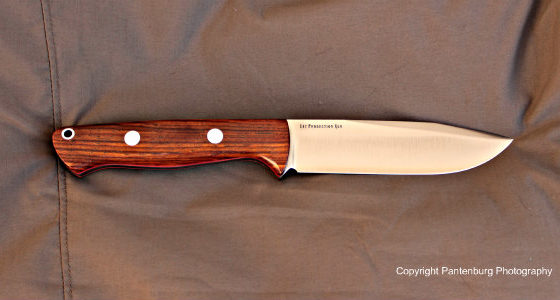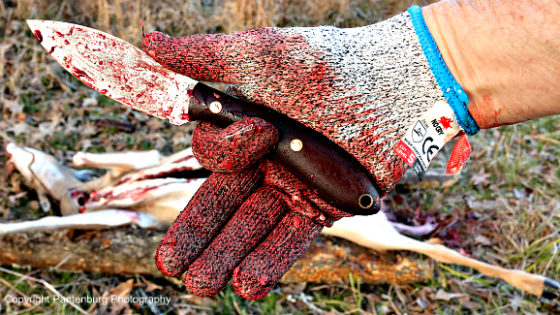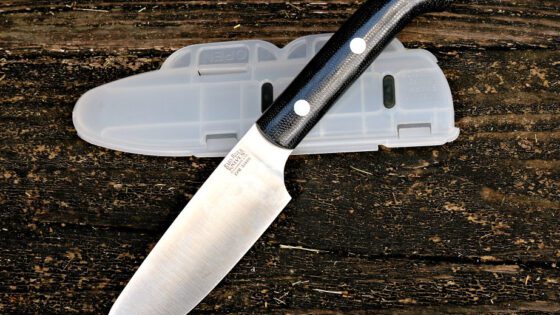A hunting knife must be able to handle a variety of different cutting tasks associated with meat processing in the field.
Here’s a new Bark River knife that has proven to be a stellar performer.
by Leon Pantenburg
This is a re-post of a review I did in 2015. Since then, knife has been used extensively on deer and elk. It worked so well I gave it Alan Bighaus, one of my hunting buddies
I got my Kalahari about six months ago, and wrung it out doing buschcrafting activities. It worked well.
But the Kalahari was designed as a big game knife, and I had to wait for a hunting season to open before I could put it to the final testing. Around Thanksgiving, I went deer hunting in Mississippi, and got to use it on a deer I killed.
Here were the circumstances: I shot the deer at dusk, and it was dead when I walked up on it. I had to drag the deer about half a mile to a road, through a deciduous forest littered with leaves. I ended up doing all the field dressing work by the light of my headlamp, in the pitch dark.
Using a knife under those conditions can be dangerous, so a smart hunter chooses his/her knife carefully. The Kalahari was used to gut, skin and quarter the animal. I split the ribcage, then cut off the head and lower legs with the knife.
Here are the Kalahari’s specifications:
Overall Length: 9.250 Inches
Blade Length: 4.5 Inches
Blade Steel: A-2 @ 58-60
Blade Thickness: .170 Inch
Weight: 7.5 Ounces
I really like:
Design: A skinning knife, IMO, should have a curved belly, because that part does all the work. The Kalahari made short work of skinning, with no nicks or cuts through the skin.
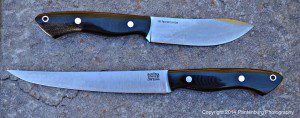
The Kalahari, top, and Sportsman work very well for every aspect of big game processing, from field dressing to final meat cutting.
Blade length: To process a big animal, you need a big blade, right? Nope – anything much past four or five inches could be overkill. The work was all done with the first four inches of the knife. Blade length
Handle: The design of the handle is more important that the material it’s made of. A hunting knife will inevitably get slick from blood, body fluids and other nasty stuff associated with field dressing. I was thoroughly impressed with the micarta handle. handle material
The deer I used it on was hit through the heart and lungs, and the body cavity above the diaphragm was filled with a bloody slurry. I had to reach inside to cut the esophagus to remove the viscera, and literally dip my hand and the knife into that mess. Even when completely wet, the micarta seemed to get “grippier” and my hand didn’t slip at all. handle design
The handle design is superb, and I’d like to see a Canadian LT with a Kalahari handle (hint, hint, hint!) The handle is long enough for me to use with my glove-sized large hands, and it was comfortable for long term cutting tasks. The knife would have been safe to use with gloves on in the cold. There is no guard on the handle, and this design doesn’t need one. (Editor’s Note: Someone was paying attention – check out the Ambush Tundra or the UP Bravo)
Point: The Kalahari’s drop point is a favorite design of mine. I was able to use the blade spine down to open up the abdominal cavity without piercing any of the intestines. This is the cut a guthook is designed for, and I don’t see the need for one on a properly-designed hunter.
Steel: The A2 steel is a superb choice. The knife was still razor sharp after I got done with all the work, and it didn’t need touching up. Even disjointing and dismembering bone didn’t affect the edge. This is a huge benefit when you are in a hurry, or have several animals to process. A dull knife is dangerous, and the Kalahari holds an edge really, really well.
Sheath: The Kalahari comes with a sturdy, well-made leather sheath. It secures the knife very well.
Other thoughts:
Blade thickness: At .17 inch thick, the blade is really sturdy. But for a skinning knife, that thickness is not needed, and it makes the blade less handy for skinning and slicing. I’ve never felt the need for a thick blade on a hunting knife.
I have not needed another hunting knife for decades. But after trying out the Kalahari, I decided to keep it and continue using it. The Kalahari has proven it can do anything I need a big game hunting knife for. From me, that’s high praise!
Please click here to check out and subscribe to the SurvivalCommonSense.com YouTube channel – thanks!

